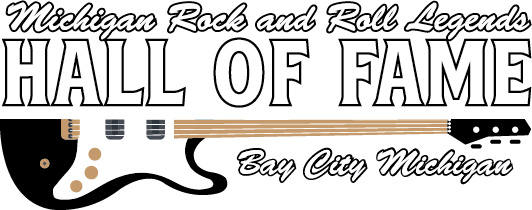Bruce Frederick Joseph Springsteen was born on Sept. 23, 1949. He was the first of three children (he had two younger sisters) to be born to Douglas and Adele Springsteen. Although he came into the world in a hospital in Long Branch, New Jersey, Springsteen grew up in Freehold, a small town of under 10,000 residents located in Monmouth County, about 15 miles west of the New Jersey shore and the coastal town of Asbury Park.
Springsteen’s father was of Dutch and Irish descent. The Springsteen’s were amongst the early Dutch families who settled in the colony of New Netherland in the early 1600s. Bruce’s mother was Italian. His grandmother was born in a small Italian town near Naples before immigrating to America.
Bruce’s sister, Virginia, was one-year younger. She was named after their father’s late sister who was killed at the age of five by a truck while riding her tricycle. The death caused a family trauma that resulted in her mother (Bruce’s grandmother) spending two years in bed following her daughter’s tragic death and Bruce’s father, neglected and suffering with rickets, sent away to live with relatives on the outskirts of town. 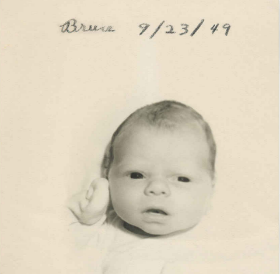 Baby Bruce
Baby Bruce
When Springsteen was born, his family lived with Bruce’s grandparents in a house at 87 Randolph Street in Freehold. Because he was the first grandchild, his grandmother latched on to him as a replacement for his dead aunt Virginia. He was allowed every freedom in the house – staying up as late as he wanted, eating what and when he wanted etc. His mother Adele, in her confusion and desire to keep the peace, ceded young Bruce to his grandmother’s dominance, resulting in a rift between Bruce and his increasingly sullen father.
Douglas Springsteen had quit school at sixteen to begin working as a floor boy in the local rug mill. At eighteen, he went to war and served as a truck driver at the Battle of the Bulge. After he returned home, he met and fell in love with Adele Zerilli. They married and started a family, but Douglas Springsteen became an unhappy man, drinking heavily and passing through a number of different jobs. According to Bruce Springsteen’s memoir, Born To Run, his father may have suffered from a form of mental illness and seemed unable to find his place in the world. 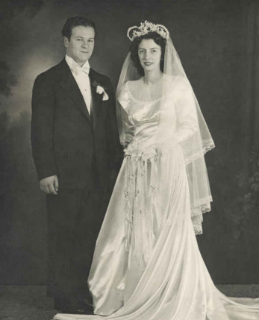 Douglas & Adele Springsteen
Douglas & Adele Springsteen
Bruce’s mother was one of three Zerilli sisters, all of whom married Irish husbands. She gave birth to three children, the third of which, Pam, was born in 1962. Adele Springsteen was the family’s main breadwinner. She worked as a legal secretary and was the rock that held the family together, providing the love to her children that her husband seemed incapable of giving.
Springsteen was raised a Roman Catholic and attended St. Rose of Lima Catholic School, located near his grandparents' home, through the eighth grade. Being raised a self-described undisciplined little tyrant by his grandmother, he resisted being forced to adapt to a regular school schedule and rules; and he was often at odds with the nuns who tried to teach and discipline him.
Bruce was seven years-old when he saw Elvis Presley’s second appearance on the Ed Sullivan Show on October 28, 1956. By this time, his parents had moved into a home of their own at 39 Institute Street. In his memoir, Springsteen wrote that Elvis got him interested in rock and roll, and he convinced his mother to take him to Deihl’s Music Store in Freehold. Since the family did not have enough money to buy him a guitar, they rented one.
After a few lessons, Bruce quit because it was too hard - his seven-year-old fingers couldn’t even get around the fret board. But before he returned the guitar, he gave a pantomimed concert with it for a half-dozen friends in his backyard. Springsteen wrote in his memoir that he “sucked”, but that just for a moment he got a sense of what he wanted to do with the rest of his life. 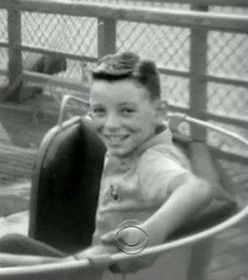 Young Bruce
Young Bruce
Since his mother loved Top 40 music, the radio was always on in the house. Young Bruce was at first captivated by novelty songs like “Western Movies” by the Olympics, “Along Came Jones” by the Coasters, and “Purple People Eater” by Sheb Wooley. From there, he became interested in records where the singers sounded simultaneously happy and sad. In the early 60s, he began gravitating to the hits of the Drifters, Sam Cooke, and Roy Orbison that he listened to on his transistor radio tucked under his pillow at night.
Bruce graduated from St. Rose of Lima after completing the 8th grade. The family had moved to a house at 68 South Street, and he transferred to Freehold High School. He didn’t fit in there either, but he experienced the ‘Big Bang’ of the Beatles during his freshman year. He bought the “Meet The Beatles” album and became obsessed with the band.
With his bangs combed down Beatles-style, Springsteen risked some afterschool beatings, but became a hit with the girls at the weekend teen dances at the local YMCA and Catholic Youth Organization. Unlike most of the other boys who wouldn’t dance to upbeat tunes, he came up with his own gyrations copped from popular dances like the Monkey, Twist, Swim, Jerk, Pony, and Mashed Potato; and he practiced his moves in front of a mirror in his room. This dedication occasionally got him on the dance floor with some of the finest girls in town, much to the envy and amazement of his friends.
His fascination with the Beatles and the other British Invasion bands led to his second attempt on the guitar. Using money from lawn and house painting jobs, Springsteen bought an acoustic guitar for $18 from the Western Auto store in Freehold. With the help of his cousin Frank, he learned to tune the guitar and play a few chords. He started out strumming songs like “Greensleeves” from a folk music book before learning to play his first rock and roll song, “Twist And Shout”. 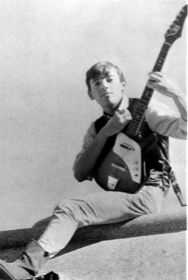 1st electric guitar
1st electric guitar
Five months later with his fingers strong and callused, he was ready to make the jump to an electric guitar. With his family lacking the money to buy him one for Christmas, Springsteen made a deal with his mother. He would sell the small pool table he received as a Christmas gift the previous year if she would pitch in the balance of the $69 dollars need to buy a Japanese-made Kent guitar with a small amp that he had seen in the window of Caiazzo’s Music Store in Freehold.
After an unsuccessful stint in his first band, the Rogues, at a dance in front of his fellow students at Freehold High, Springsteen dedicated himself to becoming a better guitar player. After a good deal of practice, he was invited by a friend named George Theiss to join the Castiles. The band was named after the shampoo that Theiss used, and their rehearsal space was Gordon “Tex” Vinyard’s apartment.
According to Springsteen’s memoir, Tex Vinyard became a surrogate father figure. Vinyard, along with his wife Marion, encouraged, managed, and put their money and time into the Castiles.
Springsteen’s relationship with his father, on the other hand, was an unrelenting battle over the length of his hair or over control over the TV set when the latest pop stars would appear on the Ed Sullivan Show or any of the other network music programs.
The Castiles’ first gig was at the Angle-Inn Trailer Park in Freehold during an afternoon cook-out. After a few lineup changes, it was on to dances at YMCAs, CYOs, high schools, skating rinks, VFW halls, battles of the bands, Elks Clubs, supermarket openings, drive-in theaters, beach clubs, and any place that wanted decent local entertainment at a cheap price. 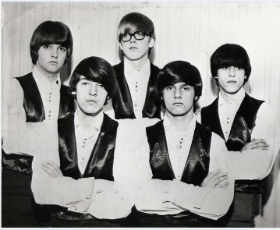 The Castiles-Bruce front left
The Castiles-Bruce front left
According to Springsteen, Freehold High had three main cliques: 1.) “The rah-rahs” – the madras-wearing cheerleaders and rich jocks with crew cuts, who like pop music; 2.) “The greasers” – mostly Italian and working class kids, sporting leather jackets, pompadours, and into doo-wop; and 3.) “The blacks” – who were also working class, separated by their skin color and into R&B music. He wrote that Motown was the only music that brought three cliques together on the dance floor, and covers of hits from the Motor City were an important part of the band's performances.
The Castiles mostly plied their trade in a chain of nightclubs and pizza parlors that catered to the teen set. Some of the places were ruled by greaser girls with teased bouffant hair, heavy eye shadow, leather boots, tight skirts and dive-bomber bras – kind of a visual cross between the Shangri-Las and the Ronettes.
The top greaser teen spot was the IB Club, and the Castiles worked in doo wop songs like “What’s Your Name” and “In the Still Of The Night” to appeal to the dancers. The top rah-rah hangouts were the Le Teendezvous night club and the Surf and Sea Beach Club.
They also played a memorable gig backing the Exciters of “Tell Him” fame at an all-black dance. The boys in the band got a little taste of rock and roll heaven when Brenda Russell and the girls in the Exciters changed into their slinky gold lame gowns in front of the Castiles in their dressing room. The Exciters went on to lip-synch their hits on stage and then performed the same songs live, backed by the Castiles, on the dance floor. 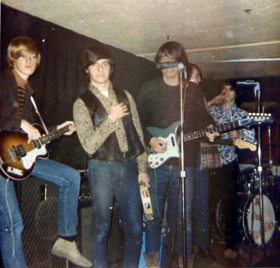 Castiles on stage
Castiles on stage
By this time, Bruce had replaced his Kent guitar with a teal-blue solid body Epiphone, a subsidiary of Gibson guitars. The guitar was used when the Castiles cut their only single, “Baby I” and “That’s What You Get For Loving Me”, at a small studio in Bricktown, New Jersey, in 1966. It was issued on a tiny local record label and only sold a few hundred copies, but releasing a single help set the band apart from most of the other teen groups in the area. The Castiles were the top band in their part of New Jersey, and that led to the decision that in order to make it bigger, they had to go to New York City. Listen to "Baby I" at: https://www.youtube.com/watch?v=aTeJTkSJMVE
Tex Vinyard got them a Saturday matinee audition with a bunch of other bands at the Café Wha? in Greenwich Village. They didn’t get paid but it was an opportunity to get your foot into the big time and possibly get noticed by a major record label. That didn’t happen for the Castiles, but they did begin to play regularly at the venue on MacDougal Street. 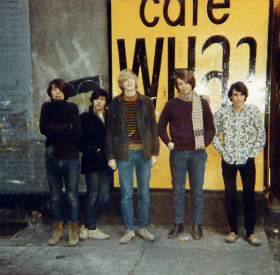 Castiles at Cafe Wha? - Springsteen left
Castiles at Cafe Wha? - Springsteen left
In 1967, Springsteen was seriously injured when his Yamaha motorcycle was hit by a car while he was riding home. Because of his concussion, he was unable to play in the band for the rest of the summer but he did meet a couple of important new friends while hanging out at local music venues.
Because of the success of the Hullabaloo TV show, a franchise was started opening teen clubs around the country. These clubs would hire local bands and it was at two of the New Jersey Hullabaloo clubs where Bruce met two future E Street Band members that summer, Vinnie “Mad Dog” Lopez and Steven Van Zandt. He and Van Zandt clicked immediately over their shared obsession with rock and roll – the beginning of a lifelong friendship.
Springsteen and Van Zandt began to take regular bus trips into the city and became immersed in the Village life with its music, hippies, gays, and drug dealers in Washington Square Park. It became their home away from home. 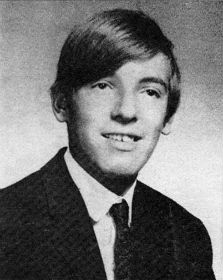 Freehold High 1968
Freehold High 1968
Bruce Springsteen was basically a loner at Freehold High. His long hair made him something of an outcast and teachers said that he was really only interested in playing his guitar. He skipped his 1968 graduation ceremony and spent the day in Greenwich Village eating pizza, hanging out at Washington Square Park and meeting a new girlfriend. Meanwhile, his house in Freehold was filled with relatives attending what was supposed to be his graduation party. When he finally returned home there was another major blow-up with his father.
1968 was significant in several other ways. Three of the Castiles were caught up in Freehold’s first major marijuana drug bust which ended the band. Springsteen was not into drugs and was not involved in the bust. He called for the draft after his 18th birthday, but he failed the physical and did not have to serve in the escalating Vietnam War. The concussion he suffered the previous year in the motorcycle accident, along with his long hair and his put-on act of weird behavior at the induction center, earned him a classification of 4F, which made him unacceptable for service.
That year also saw the rise in popularity of hard rocking psychedelic power trios, like Cream and the Jimi Hendrix Experience, in which long blues-drenched jams were the order of the day. Springsteen jumped on the trend by forming his own trio with a local drummer and bassist and calling his band Earth. The band was a popular local attraction and played in a variety of New Jersey clubs. Springsteen reportedly acquired his nickname “The Boss” at this time because he took on the task of collecting the band’s pay at the club gigs and distributing it amongst his bandmates. 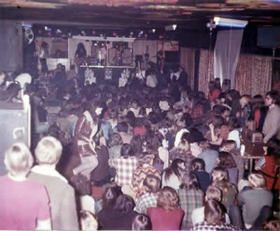 The Upstage - Asbury Park
The Upstage - Asbury Park
The first club that Springsteen played in Asbury Park was an upstairs, no-alcohol, music venue and local musician hangout called The Upstage. It was there that he reconnected with Vinnie Lopez and met two other future E Street Band members, Danny Federici and Garry Tallent. Springsteen formed a new band that included Lopez and Federici called Child, a group that later evolved into Steel Mill.
It was at The Upstage that Springsteen began to build up a huge reputation as a guitar wizard. Steven Van Zandt and Southside Johnny Lyon also jammed regularly at the club. The Upstage ran for almost four years and is credited with being the birthplace of the Asbury Park music scene. 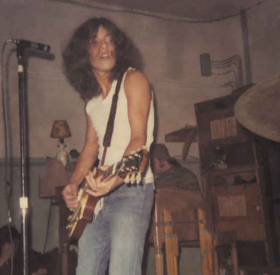 Bruce at The Upstage
Bruce at The Upstage
In 1969, Douglas Springsteen decided to move the family to California to start a new life. Bruce opted to stay in New Jersey and continue his music career and his sister Virginia, who had recently married and was newly pregnant, also stayed behind. His parents and youngest daughter Pam packed all their belongings on the top of their car and drove to San Mateo, California, where they rented a small apartment and tried for a new beginning.
Bruce, Vinnie Lopez, along with Danny Federici and his wife, took over the rent on the Springsteen house on South Street and quickly turned it into, in Springsteen’s words, “a hippie frat house”. After one month of outrageous behavior that angered everyone in the neighborhood, the landlord came to the door to tell them he was closing the house for renovations and they would have to move out. Bruce was nineteen. He would not live in Freehold again, but his hometown would never completely leave him.
